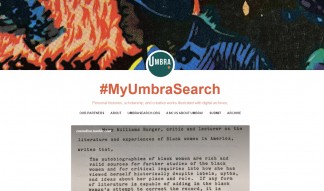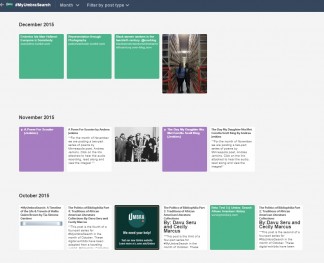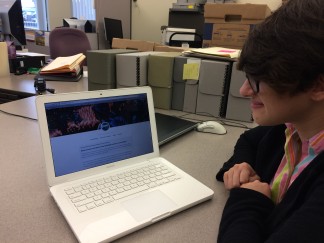By Monika Hetzler
#MyUmbraSearch Curator / Umbra Student Liaison
 Umbra: Search African American History (umbrasearch.org), a project led by the Givens Collection of African American Literature at the University of Minnesota Libraries, with Penumbra Theatre Company, is a freely available online search tool for African American history and culture. Now in beta, Umbra brings together over 400,000 digitally available items that document African American cultural history from over 500 archives, libraries, and cultural heritage institutions in the United States.
Umbra: Search African American History (umbrasearch.org), a project led by the Givens Collection of African American Literature at the University of Minnesota Libraries, with Penumbra Theatre Company, is a freely available online search tool for African American history and culture. Now in beta, Umbra brings together over 400,000 digitally available items that document African American cultural history from over 500 archives, libraries, and cultural heritage institutions in the United States.
In order to bring to life the incredible materials found in Umbra, we introduced #MyUmbraSearch this past August. #MyUmbraSearches are digital exhibits narrated by students, professors, artists, and community members, and are illustrated with materials found in Umbra. The exhibits are hosted on Umbra’s Tumblr site and featured on the Umbra homepage. #MyUmbraSearch highlights the significance of the many items discoverable in Umbra and restores some of the context that can be lost in a digital aggregation. It also is an opportunity to amplify the many silences in our national history by calling attention to where  one may fail to find relevant materials in Umbra’s national digital collection. From materials that were never preserved to rich collections that have not been digitized due to lack of infrastructure or funding, #MyUmbraSearch strives to identify and fill the gaps within and among our collections.
one may fail to find relevant materials in Umbra’s national digital collection. From materials that were never preserved to rich collections that have not been digitized due to lack of infrastructure or funding, #MyUmbraSearch strives to identify and fill the gaps within and among our collections.
The first post we built focused on the photography of jazz musicians and served as a test case for #MyUmbraSearch. In creating this exhibit, it became clear to me how relevant these raw archival documents are to our personal lives–to my personal life. The exhibits reveal how primary documents—photographs, sound recordings, letters—have the potential to spark dialogues about how history is told, and who gets to tell it.
 Professors and students at the University of Minnesota have used Umbra and #MyUmbraSearch to create digital exhibits for class projects this past semester: From the role of Black domestic labor in 20th-century America to an intimate examination of activist, playwright, and scholar Endesha Ida Mae Holland, the diversity of these exhibits exemplifies the urgency of representing African American cultural history as fully as possible. Local artists, including Andrea Jenkins, illustrate with primary documents the inspirations and manifestations of their creative works.
Professors and students at the University of Minnesota have used Umbra and #MyUmbraSearch to create digital exhibits for class projects this past semester: From the role of Black domestic labor in 20th-century America to an intimate examination of activist, playwright, and scholar Endesha Ida Mae Holland, the diversity of these exhibits exemplifies the urgency of representing African American cultural history as fully as possible. Local artists, including Andrea Jenkins, illustrate with primary documents the inspirations and manifestations of their creative works.
Beginning in 2016 as part of a grant from the Doris Duke Charitable Foundation to reach a broad and diverse audience, #MyUmbraSearch will be a forum for site users, as well as for the curators and archivists around the country who have partnered with us and contributed content to Umbra. Partners from University of Massachusetts Amherst, Temple University, and many more, will be creating exhibits highlighting materials from their home collections that are found in Umbra.
 As the many exhibits reveal, these archives are personal. Archival materials are not just lovely old folios or dusty boxes sitting in a library basement. By uniting disparate, digitized collections and personal narratives, #MyUmbraSearch works to show the personal connections to the archival material that has been collected and widely shared, and to amplify the many individual voices and histories that must now be heard.
As the many exhibits reveal, these archives are personal. Archival materials are not just lovely old folios or dusty boxes sitting in a library basement. By uniting disparate, digitized collections and personal narratives, #MyUmbraSearch works to show the personal connections to the archival material that has been collected and widely shared, and to amplify the many individual voices and histories that must now be heard.
—Monika Hetzler is a junior in the Department of Art History, and is the curator for #MyUmbraSearch and student liaison for Umbra.




